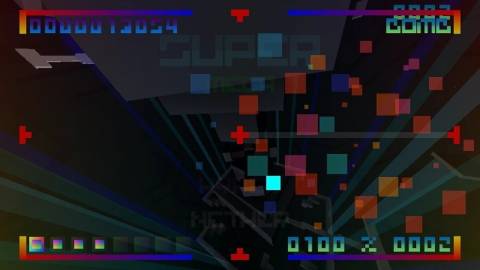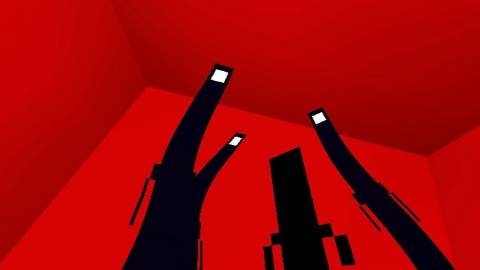
The six-episode series, about to get its second installment next Monday in Bit.Trip Core, actually tells a continuous storyline about a nebulous but excellently named figure, Commander Video. Talking to Neuse made me think of Bit.Trip as a concept album, the way a record like Pink Floyd's The Wall tells a story with music rather than more conventional narrative means. It seems like Gaijin is trying to do the same thing here--only they've got trippy retro visuals and twitchy rhythmic gameplay to act as storytelling tools along with the music.
You'd know about all this if Neuse explained it to you over a conference-room table, as he did for me. But you might miss Bit.Trip Core's narrative elements if you came to the game with no prior information. Some of you may be so harried by the gameplay's frantic demands that you won't even notice whatever thematic elements have been tucked subtly away beneath the thumping beats and day-glo light show. Luckily, you don't have to find them; Neuse allows that if the game weren't still fun when stripped of its peripheral elements it would constitute a failure of his game design.

Of course it's not really that easy, since it's about halfway through the first level before the dots come at you fast enough to fluster you, and then maybe a few more minutes before you're scrambling to even keep up with them at all. The game kicks into a great effect when you're on the verge of losing: it drops its Rez-like crazy backgrounds, goes completely black and white, and plays all of the (reduced) music and sounds through the Wii-mote speaker.
You can get a basic sense of how the game plays from this trailer, though it does get way harder than this.
The dot patterns are the same every time, so part of playing Core well is simple memorization. Many of the dots cross more than one of the four cardinal directions as they arc around, though, so you can vary up the songs a little by choosing which beam to hit a dot with--which will in turn change up the melody a bit. There's an occasional power-up that gives you a two-way beam, but also a power-down that turns your plus (and your controls) 90 degrees. In gameplay terms, the appeal here seems to be along the lines of the Guitar Hero school of rhythm design, with an emphasis on practice and repetition in order to achieve perfect playing that in turn creates the best possible musical experience.
The Wii seems to have found its answer to Art Style or PixelJunk with the Bit.Trip games, whether you come to them looking for high-concept storytelling or just good, clean rhythm action. Given the combination of aesthetic consistency and gameplay variation between Beat and Core so far, it'll be interesting to see what directions Gaijin pursue with the remaining four installments. Check out our video interview with Neuse for a little more insight into where the series is going.